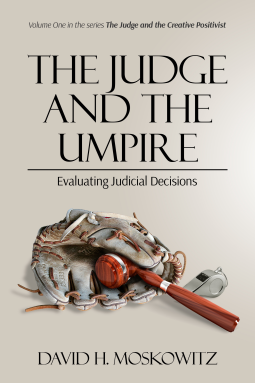
The Judge and the Umpire
Evaluating Judicial Decisions
by David H Moskowitz
This title was previously available on NetGalley and is now archived.
Send NetGalley books directly to your Kindle or Kindle app
1
To read on a Kindle or Kindle app, please add kindle@netgalley.com as an approved email address to receive files in your Amazon account. Click here for step-by-step instructions.
2
Also find your Kindle email address within your Amazon account, and enter it here.
Pub Date 26 Sep 2022 | Archive Date 8 Jul 2024
Talking about this book? Use #TheJudgeandtheUmpire #NetGalley. More hashtag tips!
Description
This book is the first of four volumes published under the series title The Judge and the Creative Positivist.
Creative positivism is a legal philosophy that is an extension of H.L.A. Hart’s legal positivist theory presented in his classic work The Concept of Law.
Moskowitz identifies ‘hard’ cases that do not fit easily into Hart’s rule of recognition; cases in which there are gaps, open texture or penumbral factual situations. He then modifies Hart’s version of the discretionary theory that limits the exercise of discretion in making judicial decisions.
The author is in a unique position to do so thanks to his having studied under Hart at Oxford, providing the latter at his request with a critique of the The Concept of Law while it was still in draft form.
He demonstrates through his creative positivist theory how discretion is exercised in ‘easy’ cases too, where the law is determinate. In so doing, Moskowitz adds to Hart’s primary and secondary rules a new set of tertiary rules.
The Judge and the Umpire springs from a reaction against a supreme court judge’s direct attempt to assimilate the two roles in his inaugural speech. In short, the author argues, because judges are authorized to create new legal rules, they are not like umpires who call balls and strikes with no authority to change the rules.
This series will be invaluable to students of US jurisprudence and legal philosophy and provide researchers with a ground shifting new theory. This first volume examines six cases in detail, providing an introduction that is accessible to undergraduates and to general readers with an interest in the context of existing judicial decisions.
Advance Praise
“David Moskowitz is masterful in explaining complex legal issues clearly and accessibly. In his series’ third volume, The Judge and the President, Moskowitz breaks down the labyrinthine criminal charges pending against Donald J. Trump in Georgia and elsewhere, revealing the strength and intricacy of the case against Trump and his co-conspirators. Even non-specialist readers will come away with a firm grasp of the legal issues at stake and how they fit into Moskowitz’s broader philosophical framework. Highly recommended!”
Prof. Michelle Madden Dempsey, Villanova Law School. Elected member of the American Law Institute and a Fellow of the American Bar Foundation; Inaugural Harold Reuschlein Scholar Chair, 2018
"This is a very readable book on a very complex subject. The book does a superb job of combining legal theory, philosophy, history, and culture. As a professor, I can say it would be appropriate for both undergraduate and graduate students. As a former elected official, I believe the book provides the questions that help us to evaluate judicial candidates in the many jurisdictions that elect judges."
Andrew E. Dinniman, Professor West Chester University, State Senator, County Commissioner
"The Judge and the Creative Positivist is an incisive and deeply learned quartet of books that extend the legal philosophy of the great English jurisprudent HLA Hart to better account for the creative aspects of judging that have long bedeviled standard positivist analyses of law. Authored by David Moskowitz, a former student of Hart’s and a practicing attorney of extraordinary and wide-ranging accomplishments, the series deserves to be read by all serious students of American law."
Mitchell Berman, Professor, Penn Carey Law School
Available Editions
| ISBN | 9781739182915 |
| PRICE | £14.99 (GBP) |
| PAGES | 246 |



